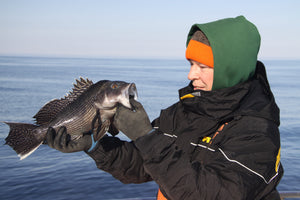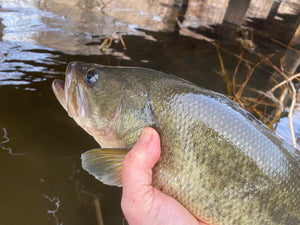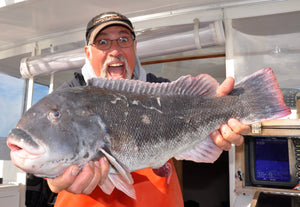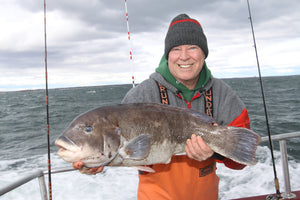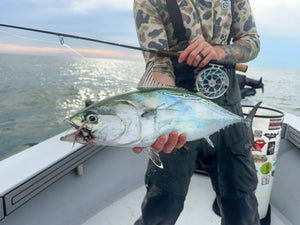Be Sharp On Hook Choices

Anglers targeting big stripers with bunker chunks often prefer small but stout circle hooks. This cow was caught and released in Long Island Sound. OutdoorTom.com photo.
Whether fishing from boat or shore, veteran anglers are extremely picky when it comes to hook selection. They understand that although there are hundreds of hook patterns in a wide range of sizes from which to choose, each size and style has been designed with a particular task in mind.
To be sure, all hooks have similarities in that they must be able to quickly penetrate a fish’s mouth and then hold tight without bending or breaking. But shape, size, thickness, shank length, barb style and other features are determined largely by various characteristics of the specific species sought.
You wouldn’t, for instance, use a codfish hook to catch a porgy — anyone can see it would be too large for the smaller scup to inhale. Wide-gap style hooks, often favored for fluke and weakfish, aren't a good choice for blackfish. The problem here is more subtle; the barb on these hooks is a little too long to quickly penetrate the tough skinned mouth of a bulldog ‘tog. Better to go with a short-point Octopus or Virginia style hook when seeking keeper white chins.
Another consideration in hook design is the type of bait to be used. The Virginia style hooks associated with blackfish are exceptionally strong and have a short point which easily pierces the jaws of bruiser 'tog. Just as important, however, the point on this hook is hard and will not bend when pushed through the shell of a green crab or momentarily stuck in a wreck. By comparison, a light wire sproat style hook, useless for blackfishing due to its lack of strength, might be substituted for a larger wide-gap when fluke show a preference for smaller, lighter baits like peanut bunker, killies, spearing or a single thin pennant of squid. In this instance, the lighter wire allows the bait to glide slightly off the bottom where it should be more enticing than if dragged through the sand and on a heavier hook. This can work especially well with a light sproat for a top hook and a larger, heavier wide gap on the bottom of a high-low rig as the top hook will work like a teaser dancing above the bigger bait every time you bounce the sinker. Try it the next time keepers invade bay and you might come away pleasantly surprised.

Big fluke love shrimp – and recent years have seen and increasing number of the crustaceans in Long Island’s eastern bays. When that happens, a single thin strip of squid or a small Berkley Gulp shrimp hooked through the head with a lightweight sproat-style hook can significantly increase your score. OutdoorTom.com photo.
The size and aggressiveness of your quarry also plays a part in hook design and selection. Strong, large and highly suspicious species such as striped bass require sturdy hooks small enough to mostly hide in a bunker chunk. Many favor a 6/0 - 8/0 circle hook for this application. At the other extreme, bluefish seem to prefer a large, bright gold or silver hook that flashes in the sunlight - and their large teeth certainly necessitate the use of a long-shank or a short length of wire leader. O'Shaughnessy or gold-colored beak bait-saver hooks are the usual choices when choppers are the target.
Another point to keep in mind when selecting a hook is that choosing larger sizes can help significantly reduce the number of "shorts" you'll catch. A 2/0 wide-gap, for example, works great with summer flounder of all sizes. A size 4/0, however, isn't as easily swallowed by sub-legal fish. Switching hooks in this manner may lower your overall catch rate but it also reduces fishing mortality by eliminating most toss-backs from the equation. That larger, stronger hook may also be the difference between decking the biggest doormat of your life or having the hook pull out as your would-be trophy tries to dodge the net.
- Bryce Poyer

